Film 5: Phases of Implementation:
The Epicenter Strategy has four distinct phases, as outline below, that happened over a five to eight-year period. The explanations given in italic below are quotes from THP’s Epicenter Strategy Brochure, with additional comments in relation to training specifically from the THPM team.
Figure 5: Phases of Implementation

3.1 Phase One: Mobilization
In phase one, communities are mobilized to participate in Vision, Commitment and Action (VCA) Workshops to develop their own vision of a different future. Local volunteers, called ‘animators’, work with their communities to make a firm commitment to achieve their shared vision of the future and create action plans for moving forward. Community-level action projects are launched and build cohesion among communities. The Hunger Project supports the community in gaining the support of Government officials and encouraging local traditional leaders and Government to contribute sufficient land for epicenter construction.
EPOs move into the community once the site is identified. Their role at this time is to sensitize the community about what the Epicenter Strategy is and what impact it can have on their community. VCA workshops are the key activity in phase one but carry on through the life of the Epicenter. SSs and EPOs all conduct VCA workshops with whole communities. Once they have been trained VCA animators then in turn conduct VCA workshops themselves in their own villages to reach the wider community. Training of first animators in the different thematic areas will also begin in phase one (see Part Two, Section Four). A learning visit may be organized to take members of the community to an established Epicenter to help them the develop a vision of what could happen in their own community.
3.2 Phase Two: Construction
Phase two begins with the construction of the L-shaped Epicenter building. Community members work together to mobilize construction materials and create a food bank, community fields, a meeting hall, a rural bank, a clean water source, public latrines and, where they don’t already exist, a health center, food processing units and classrooms.
The Epicenter quickly becomes a vibrant center of community action and a strong symbol for positive change.
To physically construct the epicenter building, The Hunger Project hires an experienced local contractor to train community members in construction. The Epicenter Committee mobilizes voluntary labor to pull together the materials (stones, sand), clear the land, construct the bricks and begin laying the foundation.
3.3 Phase Three: Program Implementation
Once the epicenter building is constructed, the community continues working to address its needs.
Training courses and other program activities occur in phase three once the Epicenter building facilities are operational. Clinics will be staffed with Government health staff, nursery school and adult literacy classes will take place, the food bank will be stocked with harvested produce and the rural bank will be opened for business. Training of animators will continue, both in the form of refresher courses and training for new animators who have joined in later years or replaced those that have dropped out.
3.4 Phase Four: Transition to Self-reliance
The Hunger Project ends its financial and staff support for the epicenter’s programs but continues to monitor progress for two additional years. This transition allows time for epicenter leadership to affirm its partnerships, ensure funding streams from revenue-generating activities and begin relying on its leadership structures for future growth. An epicenter that has reached sustainable self-reliance exhibits:
- Effective, gender-balanced and fully trained epicenter leadership, with democratic processes and transparency;
- A strong Women’s Empowerment Program;
- Access to basic services, including healthcare, education, clean water, agricultural tools, and microfinance savings and credit opportunities; and
- Epicenter income, with revenues that cover all expenses and a self-reliant microfinance institution.
In general, following five years of frequent visits and training courses by Hunger Project staff, (there is) one year of intensive work to solidify the program implementation and two years of transition for an epicenter to reach a point of self-reliance.
